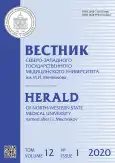The comparison of revalcularization outcomes in acute coronary syndrom following primary coronary angioplasty
- Authors: Abramova O.V.1, Saiganov S.A.1
-
Affiliations:
- North-Western State Medical University named after I.I. Mechnikov
- Issue: Vol 12, No 1 (2020)
- Pages: 21-30
- Section: Original study article
- URL: https://journals.rcsi.science/vszgmu/article/view/25815
- DOI: https://doi.org/10.17816/mechnikov202012121-30
- ID: 25815
Cite item
Full Text
Abstract
Purpose. To compare clinical and morphofunctional outcomes of revascularization in patients after primary coronary angioplasty with different degree of coronary arteries damage and type of myocardial infarction.
Material and methods. The research involved 258 patients after myocardial infarction who underwent coronary balloon angioplasty with stenting infarct-related artery. By electrocardiographic and angiographic picture all patients were divided into 4 groups: Q-wave myocardial infarction and without Q-wave myocardial infarction with single-vessel and multivessel disease.
Results. The study found that the patients with non Q-wave myocardial infarction and single-vessel disease had no adverse clinical outcomes during a year. The wall motion index and the ejection fraction almost recovered completely (wall motion index varied from 1.18 ± 0.02 to 1.05 ± 0.02 and ejection fraction — from 57.4 ± 0.5% to 63.3 ± 0.6%; р < 0.001). All the patients with Q-wave myocardial infarction revealed similar clinical outcomes and morphofunctional characteristics. The group of patients with non Q-wave and multivessel disease had the highest rate of adverse clinical outcomes with progressing left-ventricular disfunction according to echocardiography (wall motion index varied from 1.15 ± 0.01 to 1.19 ± 0.04 and ejection fraction — from 53.9 ± 0.5% to 55.1 ± 0.6%; р < 0.001).
Conclusion. The degree of coronary arteries damage in the patients with Q myocardial infarction did not influence postinfarction remodeling and long-term cardiac outcomes. The patients with non-Q myocardial infarction and single-vessel disease had fewer signs of postinfarction remodeling and complications in postinfarction period. The worst prognosis was revealed by patients with similar forms of myocardial infarction and multivessel disease.
Full Text
##article.viewOnOriginalSite##About the authors
Olga V. Abramova
North-Western State Medical University named after I.I. Mechnikov
Author for correspondence.
Email: abramova.olja@mail.ru
Head of ICU of patients with myocardial infarction Russian Federation, Saint Petersburg
Sergey A. Saiganov
North-Western State Medical University named after I.I. Mechnikov
Email: Sergey.Saiganov@szgmu.ru
Professor, head of the Department of Hospital Therapy and Cardiology named after M.S. Kushakovsky Russian Federation, Saint Petersburg
References
- Нифонтов Е.М., Галагудза М.М., Трусов И.С. Тромболизис – чрескожное коронарное вмешательство при остром коронарном синдроме с подъемом сегмента ST: смена акцентов // Медицинский совет. – 2016. – № 5. – С. 20–25 [Nifontov EM, Galagudza MM, Trusov IS. Trombolizis – chreskozhnoe koronarnoe vmeshatel’stvo pri ostrom koronarnom sindrome s pod”emom segmenta ST: smena aktsentov. Meditsinskiy sovet. 2016;(5):20-25. (In Russ.)]. https://doi.org/10.21518/2079-701X-2016-05-20-25.
- Sinnaeve PR, Armstrong PW, Gershlick AH, et al. ST-segment-elevation myocardial infarction patients randomized to a pharmaco-invasive strategy or primary percutaneous coronary intervention: Strategic Reperfusion Early After Myocardial Infarction (STREAM) 1-year mortality follow-up. Circulation. 2014;130(14):1139-1145. https://doi.org/10.1161/circulationaha.114.009570.
- Шилова А.С., Новикова Н.А., Щекочихин Д.Ю., Сыркин А.Л. Отдаленные исходы у пациентов с острым коронарным синдромом с подъемом сегмента ST при применении фармако-инвазивного подхода и первичного чрескожного коронарного вмешательства: результаты двухлетнего наблюдения в условиях реальной клинической практики // Клиницист. – 2015. – Т. 9. – № 4. – С. 22–27. [Shilova AS, Novikova NA, Shchekochikhin DY, Syrkin AL. Long-term outcomes in patients with ST-segment elevation acute coronary syndrome in application of a pharmacoinvasive approach and primary precutaneous coronary intervention: results of a two-year follow-up in real clinical practice conditions. Clinician. 2015;9(4):22-27. (In Russ.)]. https://doi.org/10.17650/1818-8338-2015-9-4-22-27.
- Westerhout CM, Bonnefoy E, Welsh RC, et al. The influence of time from symptom onset and reperfusion strategy on 1-year survival in ST-elevation myocardial infarction: а pooled analysis of an early fibrinolytic strategy versus primary percutaneous coronary intervention from CAPTIM and WEST. Am Heart J. 2011;161(2):283-290. https://doi.org/10.1016/j.ahj.2010.10.033.
- Danchin N, Coste P, Ferrières J, et al. Comparison of thrombolysis followed by broad use of percutaneous coronary intervention with primary percutaneous coronary intervention for ST-segment-elevation acute myocardial infarction: data from the french registry on acute ST-elevation myocardial infarction (FAST-MI). Circulation. 2008;118(3):268-276. https://doi.org/10.1161/CIRCULATIONAHA.107.762765.
- Ибрагимов Р.М., Мацкеплишвили С.Т., Амбатьелло С.Г., и др. Особенности прямой реваскуляризации миокарда у больных с мультифокальным атеросклерозом при остром коронарном синдроме без подъема сегмента ST // Анналы хирургии. – 2012. – № 6. – С. 20–24. [Ibragimov RM, Matskeplishvili ST, Ambat’ello SG, et al. Aspects of a direct revascularization of myocardium in patients with multifocal atherosclerosis with acute coronary syndrome without ST segment elevation. Annals of surgery. 2012;(6):20-24. (In Russ.)]
- Thygesen K, Alpert JS, Jaffe AS, et al. The fourth universal definition of myocardial infarction. Eur Heart J. 2019;40(3):237-269. https://doi.org/10.1093/eurheartj/ehy46.
- Schiller NB, Shah PM, Crawford M, et al. Recommendations for quantitation of the left ventricle by two-demensional echocardiography: American Society of Echocardiography Committee on Standards, Subcommittee on Quantitation of Two-Demensional Echocardiograms. J Am Soc Echocardiogr. 1989;2(5):358-367. https://doi.org/10.1016/s0894-7317(89)80014-8.
- Мкртумян A.M. Кардиоваскулярные осложнения сахарного диабета 2-го типа и особенности коррекции углеводного обмена // Сердце. – 2003. – Т. 2. – № 6. – С. 266–271. [Mkrtumyan AM. Kardiovaskulyarnye oslozhneniya sakharnogo diabeta 2 tipa i osobennosti korrektsii uglevodnogo obmena. Serdtse. 2013;2(6):268-277. (In Russ.)]
Supplementary files










